A Home-built Video Disk Recorder
When building your own vdr you will have to make
choices. Some of the requirements are contradictory, some of the
choices difficult. This page reflects the choices I've made. The main
criterion was keeping the PC quiet. Keeping a PC quiet implies keeping
it cool, as fans are a major noise source. Surprisingly enough, the
main source of heat is not the CPU but the DVB tuner cards. Each tuner
card dissipates up to 8W. In general, the more recent tuner designs
consume less than older ones.
CPU

The cpu used is a socket 478 Celeron 2.0 GHz, C1 stepping. Chosen
because the worst-case heat dissipation of 52.8W - what Intel calls
Processor Thermal Design Power - vs. clock frequency compares
favourably with other models.
When watching TV the CPU is 90% idle; CPU temperature reaches 37ºC
at an ambient temperature of 21ºC and a fan speed of 1000 rpm.
Maximum temperature is about 45ºC, fan running at 1400 rpm.
A 2 GHz Celeron CPU is too slow to watch HDTV. A 3 GHz Pentium IV with
hyperthreading is quite capable of showing HDTV in real time, but
generates so much heat fan noise becomes a nuisance. YMMV.
Cooler

The CPU cooler is an
Arctic
Cooling Super Silent 4 Ultra. Reasonably quiet; does its job.
To slow down the CPU fan a temperature-dependent speed control from
noisemagic.de
was added.
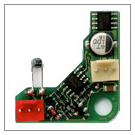
Memory

Memory is 256 mb PC2100 ram. You need enough memory to avoid any
swapping, and 256 mb is just about right.
If you wish to run all user programs from a ram disk you might want to
double this to 512 mb ram. Running user programs from a ram disk allows
you to spin down the hard disk when not recording or watching
recordings. Spinning down the hard disk lowers noise.
Motherboard
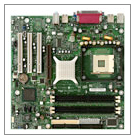
Motherboard is an Intel
D865GLC
micro-ATX motherboard. This is a fairly conservative choice, as I
wanted a board that followed the PCI spec
exactly.
The motherboard allows for mounting the PCI cards vertically; this
increases system height but makes convection cooling easier.
Video
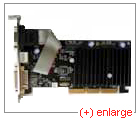
Putting a hugely powerful video card in your vdr is probably quite
unnecessary. Let's consider two setups: a classic vdr setup and a more
modern one.
- In a classic vdr setup you don't even use your video
card: you watch TV using the TV out of the full-featured
DVB card; unless you happen to be installing or upgrading linux you
won't even have a PC monitor connected. As the MPEG2 decoding is done
by the DVB card CPU requirements are low.
The TV out of full-featured DVB cards is quite good at what it's made
for: watching standard definition
MPEG1 or MPEG2 streams of up to 10 Mbit/s on a conventional analogue
TV. However, if you want to watch High-Definition
TV, if you want to watch DiVX or MPEG4, or if your TV has a DVI or HDMI
input you may want to start looking for alternatives.
- A more modern approach uses your PC's graphics card. The xine,
mplayer
and softdevice
plug-ins are different projects to watch TV on the graphics card. This
approach doesn't need that much processing power in your video card
either - when watching movies, all those 3D graphical features are
quite useless. However, if MPEG decoding is done in software it can
require a fair amount of CPU, especially at higher resolutions.
The main question is whether your video card provides the resolution
you need and the MPEG hardware support you want. Look for IDCT (Inverse
Discrete Cosine Transform) and MC (Motion Compensation) in the hardware
spec. In linux, this corresponds to XvMC software support.
Just in case you thought that a DVI digital connection to your TV means
analogue is something of the past: in the TV I'm using - a Philips
32PF9976 - the DVI connection terminates in a Silicon Image SiI905
chip; a DVI to RGB analogue converter.
You cannot use every AGP card in every AGP slot; before buying check
compatibility.
My personal choice is an Aopen
FX5200-DV256, a fully passively cooled nVidia card. No fan, no
noise.
Hard disk

Hard disk is a 250 Gb Samsung
HA250JC SpinPoint. Disk size determines how many hours of movies
you can store. A handy rule of thumb is that one hour of standard
definition TV needs more or less one gigabyte of disk space. Hence, 250
Gb corresponds to more than ten days of uninterrupted movie-watching.
This disk spins at only 5400 rpm, but I neither need nor want a faster
disk: I prefer a quiet disk to a fast one. High disk speed adds nothing to
viewing pleasure.
DVD drive
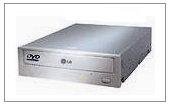
A DVD
drive for watching the occasional DVD or Video CD. Choose a quiet
one.
Power Supply
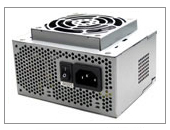
Power supply is a Seasonic
200SFD with temperature-controlled fan. Again, this is chosen with
noise levels in mind.
Infrared receiver and wake-up board
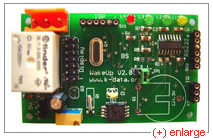
In addition to a LIRC remote control receiver you also
want to switch the PC on by remote control. I'm using a ready-made
microcontroller board bought from k-data
(info at nospam.k-data.org) running software from Frank Jepsen.
The board contains a small real-time clock that automatically switches
the pc on when a TV programme needs recording. Unfortunately,
documentation is only available in German.
DVB cards
Before buying a card it's probably not a bad idea to take a look at the
supported
hardware list in the
linuxtv project. Even so, I
suggest sticking to the most commonly used hardware: not all cards are
equally well supported. A classical vdr setup is one with a single
full-featured DVB card, possibly extended with multiple budget
DVB-cards. The setup I'm using consists of two terrestrial DVB-T and
one satellite DVB-S tuner. This fills all motherboard PCI slots.
Full-featured DVB-T
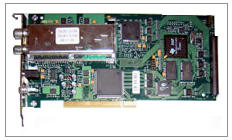
Full-featured Technotrend DVB-T. On-board DSP
memory was increased from 2 mb to 4 mb by Wolfsoft;
and a small circuit board was made to
provide a SCART output. Note that this is an already aging design; the
DVB-T tuner is not very sensitive when compared to the "budget" DVB-T
card. Not recommended for new systems.
Budget DVB-T
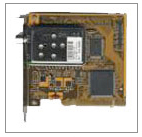
Technotrend DVB-T. The tuner of the "budget" card is a lot more
sensitive than the tuner of the full-featured card.
Budget DVB-S
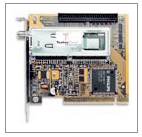
Technotrend DVB-S.
All DVB cards were bought from dvbshop.
The local TV stations all schedule movies more or less at the same
time. Having multiple tuners allows recording multiple programmes at
the same time. Recording four movies simultaneously is not unusual. Six
simultaneous recordings is feasible, but then the system becomes
sluggish. Commercials are removed later using noad.
Should you be interested in USB DVB tuners, please note that USB 1.0
and 1.1 designs have only limited bandwidth, adequate for a single SDTV
channel only. USB 2.0 tuners are a better choice; they're fast enough
to record multiple SDTV channels in parallel - if the SDTV channels all
use the same frequency.
The satellite dish is a a 90 cm aluminium offset dish
Triax TDA88 /
Flexibloc with dual Alps LNB's for Astra 19.2º
and Eutelsat Hotbird
13º satellites. Channels I actually receive are:
Satellite channels received
|
TV |
Radio |
| Free to air |
764 |
757 |
| Encrypted |
933 |
140 |
A few transponders are missing because I'm not exactly in the center of
their beams.
Software
Klaus
Schmidinger's vdr
running on top of a 2.6 linux kernel. lirc is used for the remote
control.
Case
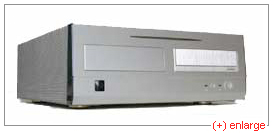
The case is a Lian Li PC-9300 Micro-ATX enclosure. A Lian Li C01-A
aluminium CD drive door was glued into place with silicone rubber. The
lid, which covers case top and sides, was removed and replaced with a
stainless steel mesh bought at a local hobby store. The open mesh
allows convection cooling.
More pictures.
Last update page: September 1, 2005








